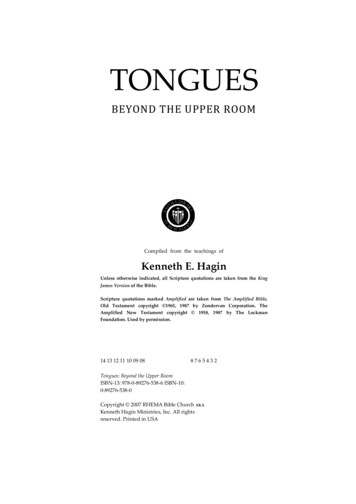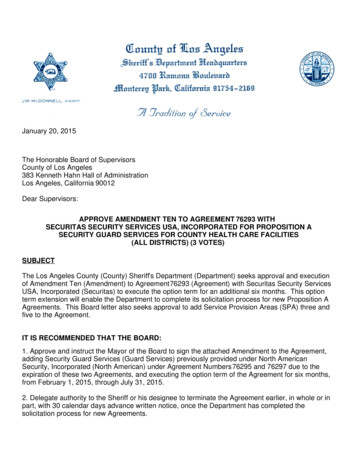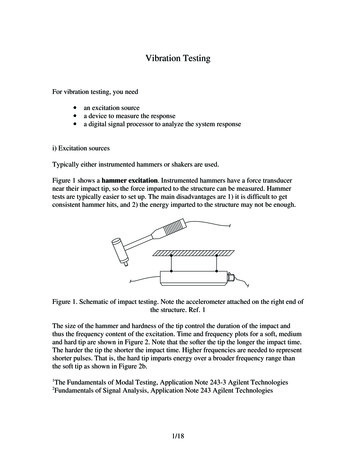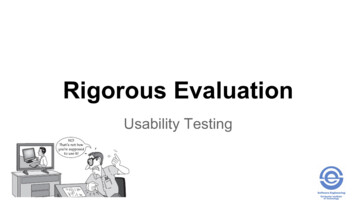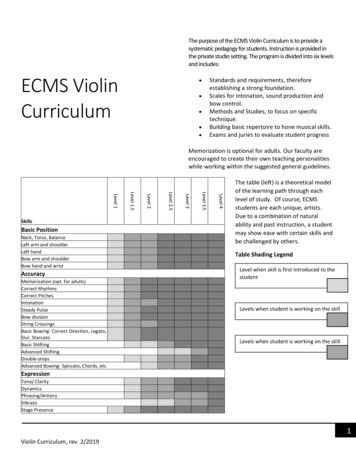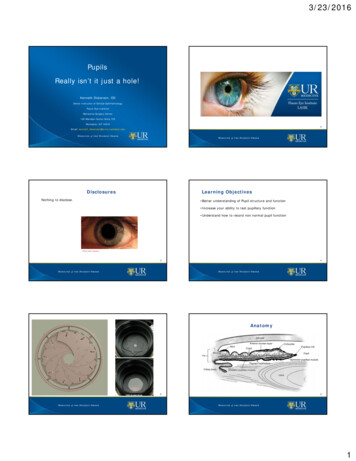
Transcription
3/23/2016PupilsReally isn’t it just a hole!Kenneth Dickerson, ODSenior Instructor of Clinical OphthalmologyFlaum Eye InstituteRefractive Surgery Center100 Meridian Center Suite 125Rochester, NY 146182Email: kenneth dickerson@urmc.rochester.eduDisclosuresLearning ObjectivesNothing to disclose. Better understanding of Pupil structure and function Increase your ability to test pupillary function Understand how to record non normal pupil function(Photo credit: Wikipedia)34Anatomy561
3/23/2016AnatomyHow does it work The Iris has two muscles the dilator muscle and constrictor muscle. The dilator muscles is arranged radially much like spokes on a wheel The constrictor muscle runs circularly around the pupil boarder.When the Constrictor muscle is activatedwhat happens to the pupil size?When the Dilator muscle is activated whathappens to the pupil size?What happens to the pupil size when lookingat a near object?78910How does it work Light activated reflex and accommodation activated reflex all wiredthrough the mid brain, with fibers split between the Optic Nerve (CN2)and Oculomotor nerve (CN3). Fibers are part of the sympathetic and parasympathetic pathways. Ready: Fight or Flight time!!! Sympathetic: Dilates the eye and gets you ready to fight or run! Parasympathetic: Constricts the pupil activates ciliary muscle foraccommodation and settles you down.How do you test it?Lights! First set the mood! You want just enough ambient light in the room so that you can seeboth pupils. This means you will need a more light for a very dark irisand less light for a light iris. Second you need a Big TargetO-Scope“E”BIOPenlight Third grab your favorite light! Choose wisely!Transilluminator penlight, transilluminator, O scope, or the BIO. You want something that will give you a concise circle of light withuniform illumination So no flash lights to much spread.11122
3/23/2016How do you test it?How do you test it? Hold your light within 25cm of the patient, do not block the line of sight. Swinging Flashlight test Move the light between the eyes rapidly (watch out for the nose) Have the patient remove there glasses and direct there gaze to the big Espending about 3-5 seconds on each eye. Shine the light into their right eye and observe the size and speed of the Observe the response (dilation or constriction) and the size of eachpupillary constriction. (Direct response)pupil at the moment when light first arrives and during the 3-5 second Repeat twiceobservation period Now adjust your observation to the left eye and shine the light into the righteye and observe the size and speed of the pupillary constriction. (Consensual Make sure you are directing the light onto the same part of the retina ineach eye and that the light is of equal intensity.response) Again repeat twice Repeat for two to three complete cycles. For the left eye repeat all the same steps1314What are you looking for?Pupils of unequal size Are the pupils round? Perform a Dim/Bright Pupillary test. Tools: Big “E” for patient fixation Are the pupils equal in size? Ophthalmoscope with largest round beam. Is there a Direct and Consensual response? Lights off in the room. Sitting 1 meter away shine the light onto the patients face so that both Is there any pupillary escape?eyes are illuminated. Measure the pupil size (bright) If are normal record as Pupils Equal Round Reactive to Light, no RelativeAfferent Pupillary Defect or PERRL-RAPD Gradually reduce the illumination to lowest that allows you to seethe red reflex. Again measure the size (dim) Repeat twice to confirm1516Pupils of unequal sizeWhat Does it mean? Anisocoria more pronounced in dim light with mild ptosis of the upper You find that there is a 1mm difference between the eyes in dim and brightand lower lid in the eye with the smaller pupil.light. Great record as “anisocoria equal in dim and bright OD OS by 1mm”(old photos back it up as well) This is Horner’s Syndrome and the most likely location for the issue iswhere? You find that there is as difference in pupil size depending on the light, you Upper chest lesionhave more to do! Have the patient look straight ahead and measure the palpebral aperture,note the position of the lids relative to the limbus. Now have the patient follow your finger to up-gaze, observe when thelimbus clears the lower lid and measure the palpebral aperture in up-gaze. Record Pupils in bright OD 3.5mm, OS 3mm/in dim OD 7.0mm, OS4.5mm/ ptosis upper lid OSPhoto credit: Steve Kofron17183
3/23/2016Those pupils are failing all these tests, whatnow?What Does it mean? Accommodative testing: Anisocoria more pronounced in bright conditions with a ptosis in the eye Tools:with the larger pupil. Big “E” This is CNIII lesion, the affected eye is most likely pointed down and Near target (something containing fine visual detail)out. Starting with the patient looking at distance and holding the near target at 10cm. Have them look at the near target, observe the pupil measuring briskness ofresponse and magnitude. Have them look back at distance to check for dilation Repeat to confirm Record by adding and A the PERRL (PERRLA) or OD unresponsive to light direct and consensual; both pupils constrict tonear; OS responds to light D&C.Photo Credit: Richard Jamara, OD19That pupil does not look normal.20How would you record these finding?Photo Credit: Dr. Tim Root, MD2122Congratulations you have now completed pupiltesting! Recommended reading resource: “Clinical Procedures for OcularExamination” by N. Carlson and D. Kurtz.Photo credit: National Geographic23244
3/23/2016255
Photo Credit: Dr. Tim Root, MD How would you record these finding? 22 Congratulations you have now completed pupil testing! 23 Photo credit: National Geographic Recommended reading resource: “Clinical Procedur



